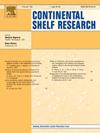Growth, mortality, and predatory impact on mesozooplankton of chub mackerel Scomber japonicus larvae in an upwelling system, southern Japan
IF 2.2
3区 地球科学
Q2 OCEANOGRAPHY
引用次数: 0
Abstract
In the northern Satsunan area, southern Japan, upwellings generated by the intrusion of the Kuroshio branch current into Kagoshima Bay are observed at the bay's mouth once every two weeks in winter and spring, and the resulting nutrient supply promotes phytoplankton blooms. Currently, this is a key spawning and nursery habitat for chub mackerel Scomber japonicus in Japan. This study examined how water temperature and prey density influenced the growth, mortality, and predatory effects of S. japonicus larvae in the northern Satsunan area. Recent growth (measured as the average width of the last three otolith increments) of S. japonicus larvae was positively correlated with water temperature but not with prey density, indicating that prey abundance was adequate for larvae and that water temperature controlled their growth rate in the study area. The instantaneous daily mortality rate of S. japonicus larvae was 0.322 in 2021 and 0.252 in 2022 (equivalent to 27.5% mortality d−1 in 2021 and 22.3% in 2022). The food requirements of S. japonicus larvae and mesozooplankton production were 0.00427 ± 0.00334 and 6.37 ± 3.04 mg DW m−3 d−1, respectively. S. japonicus larvae had no significant predatory impact on mesozooplankton (0.0869 ± 0.0796%). The present study suggests that none of the plankton feeders have a significant top-down regulating effect on mesozooplankton biomass in the northern Satsunan area, which provides a good food environment for S. japonicus larvae.

日本南部一个上升流系统中鲐鱼幼鱼的生长、死亡和捕食对中浮游动物的影响
在日本南部的Satsunan北部地区,冬季和春季每两周在鹿儿岛湾的河口观察到一次黑潮分支流入侵所产生的上升流,由此产生的营养供应促进了浮游植物的大量繁殖。目前,这里是日本鲐鱼(Scomber japonicus)主要的产卵和育苗栖息地。本研究考察了水温和猎物密度对日本刺参幼虫生长、死亡和捕食效果的影响。日本刺参幼虫的近期生长(以最后三个耳石增量的平均宽度测量)与水温呈正相关,而与猎物密度不相关,表明研究区猎物丰度足够,水温控制了幼虫的生长速度。2021年和2022年日本血吸虫幼虫的瞬时日死亡率分别为0.322和0.252,分别相当于2021年和2022年的27.5%和22.3%的死亡率。日本刺参幼虫和中浮游动物的需食量分别为0.00427±0.00334和6.37±3.04 mg DW m−3 d−1。日本刺参幼虫对中浮游动物的捕食影响不显著(0.0869±0.0796%)。本研究表明,所有浮游生物饵料对Satsunan北部地区中浮游动物生物量的自上而下调节作用均不显著,为日本刺参幼虫提供了良好的食物环境。
本文章由计算机程序翻译,如有差异,请以英文原文为准。
求助全文
约1分钟内获得全文
求助全文
来源期刊

Continental Shelf Research
地学-海洋学
CiteScore
4.30
自引率
4.30%
发文量
136
审稿时长
6.1 months
期刊介绍:
Continental Shelf Research publishes articles dealing with the biological, chemical, geological and physical oceanography of the shallow marine environment, from coastal and estuarine waters out to the shelf break. The continental shelf is a critical environment within the land-ocean continuum, and many processes, functions and problems in the continental shelf are driven by terrestrial inputs transported through the rivers and estuaries to the coastal and continental shelf areas. Manuscripts that deal with these topics must make a clear link to the continental shelf. Examples of research areas include:
Physical sedimentology and geomorphology
Geochemistry of the coastal ocean (inorganic and organic)
Marine environment and anthropogenic effects
Interaction of physical dynamics with natural and manmade shoreline features
Benthic, phytoplankton and zooplankton ecology
Coastal water and sediment quality, and ecosystem health
Benthic-pelagic coupling (physical and biogeochemical)
Interactions between physical dynamics (waves, currents, mixing, etc.) and biogeochemical cycles
Estuarine, coastal and shelf sea modelling and process studies.
 求助内容:
求助内容: 应助结果提醒方式:
应助结果提醒方式:


